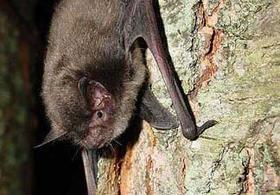
A dead bat discovered under a turbine in the North Allegheny Windpower Project has put a freeze on their nighttime operation. The 35-turbine farm in Portage, Washington, and Cresson townships in Cambria County is the second location where endangered Indiana bats have been found dead under turbines. Two bats were found at a wind farm in the Midwest.
Clint Riley, supervisor of the Pennsylvania field office of the U.S. Fish and Wildlife Service, said that the Indiana bat has been listed on the Endangered Species list since 1967. He said human disturbance of hibernating bats and a disease called white-nose syndrome make them vulnerable. White-nose syndrome, named after a white fungus found on the noses of infected bats, has killed more than a million bats since being discovered in 2006.
Riley said that, while he’s concerned about the find, dead Indiana bats have only been discovered in a couple of instances. “Whether they’re found has as much to do with whether wind operations are conducting post-construction monitoring to search for them and calibrating how frequently they would find them,” said Riley. “We do encourage wind operations to conduct monitoring of their sites so we can learn more about the extent to which bats, birds, or other wildlife may be affected by them.”
Volunteers found the bat during daily monitoring of the farm, owned by Duke Energy Corporation, on September 26th. Duke then brought in a bat expert for confirmation.
He said there are various measures companies can enact to prevent future incidents. “Current operational measures for bats, that are most likely to have a benefit, involve looking at the speed of the wind and adjusting where you would begin turbine operations at a higher rate of speed,” said Riley. “It appears that bats are most active at lower wind speeds and least likely to be active at higher wind speeds.”
Riley said they plan on meeting with Duke to discuss further precautions the company can take to avoid any more problems.




